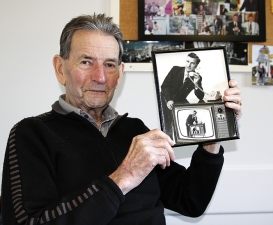Search

 Ron Arthur was heavily involved in introducing television to New Zealand in his younger years. Photo Susan SandysIt was the birth of a new era when television came to New Zealand 60 years ago. Ashburton’s Ron Arthur was among those helping to bring the magic of moving pictures into living rooms. Susan Sandys reports.
Ron Arthur was heavily involved in introducing television to New Zealand in his younger years. Photo Susan SandysIt was the birth of a new era when television came to New Zealand 60 years ago. Ashburton’s Ron Arthur was among those helping to bring the magic of moving pictures into living rooms. Susan Sandys reports.
Ron Arthur spent much of his childhood in Ashburton, and was an enthusiastic Air Training Corps Ashburton member as a teenager in 1950.
Under the direction of Flying Officer Scott, he would co-pilot Tiger Moths on flights from the airport at Ashburton on Sundays, the open-cockpit experience a highlight of his young years.
“You just sat there and the wind used to blow through your hair,” he said.
Leaving his Ashburton High School days behind, Ron went off to compulsory military training at the age of 18 at Whenuapai before settling in Nelson.
His earlier fascination with Tiger Moths was soon replaced by something just as exciting – television.
Ron co-owned and managed three home appliance businesses in the area – at Motueka, Stoke and Nelson.
After television was introduced to New Zealand in 1960, he was among those who dedicated themselves to bringing the new medium to his area.
He was the first retailer to stock televisions in Nelson, but selling the sets went hand-in-hand with gaining transmission.
“The people wouldn’t just buy a TV set, we had to bring it into their house, show them what type of signal they were going to get, and then they would buy it from you,” he said.
“And when we took TV sets into people’s homes to try, you should have seen their faces, they used to light up.”
There could be as many as a dozen people at each house, neighbours having come along as well.
And the moment of turning on the TV for the first time was always highly anticipated by the awaiting audience.
The lights would go off, curtains were drawn, and everyone would be silent.
“They were quite exciting days when we first started,” he said.
Ron had become involved with technicians in Nelson who were monitoring the signal from Wellington and ultimately managed to get a permanent signal in the early 1960s.
That was just the beginning however, and being able to push the signal into the valleys around the area became a labour of love.
Ron and the technicians would find themselves walking up many a high hill to install aerials and transmitters, with the help of a donkey to carry their equipment.
The higher the better, and at least one was installed on the top of a 12-metre high pine tree.
Ron climbed up the tree himself, with a tomahawk in hand to chop down branches along the way.
There was a near miss that day when he accidentally dropped the tomahawk and it landed near the technician’s foot.
Ron recalled a public meeting about television coming to the area in a Tapawera community hall, with about 60 people who were interested in seeing what this new technology would be like.
There were three to four sets on the stage, their modern façade sparkling and set off perfectly by the blue carpet.
Soon, at the push of a large button positioned near the channel dial on each set, the room was transformed.
“We turned those on, and the people went ‘wow’.”
About 15 families bought television sets that night.
The few who were first to get television in those early days got used to having people sit outside their homes, peering through the window watching it.
This happened to Ron at his own house as well, but he encouraged it as he wanted people to see how fantastic TV was.
He even put a speaker out to his front lawn, so people coming along and looking through the window at the TV could also hear the audio.
However, as spectacular as television was, depending on where one lived, it could take some dedication to watch it.
When the screen was “snowy”, getting some distance from it could make things better, perhaps similar to the technique people try today of squinting their eyes to see through pixelation.
“You had to be at least 20 feet away, because the picture was snowy. If you were some distance away you could see it,” he said.
Those first people getting television sets also relied heavily on Ron to inform them about how they worked, and if they didn’t work, why not.
He said television used to automatically switch off at midnight, and every night at that time he would get phone calls from new television owners asking him why their screen had gone blank.
Indeed, it was the dawn of a new age, and one that Ron was very happy to be involved in.
“That was the best thing in my life,” Ron said.
“It was a great thrill to be involved along those lines, to see those things happening.”
Today, at the age of 85, Ron has a black and white photograph which reminds him of the wonder of those years.
In the picture, which was taken as a promotional image for his store, he is taking a phone call and leaning on a new television set.
© The Ashburton Guardian - 13 June 2020


